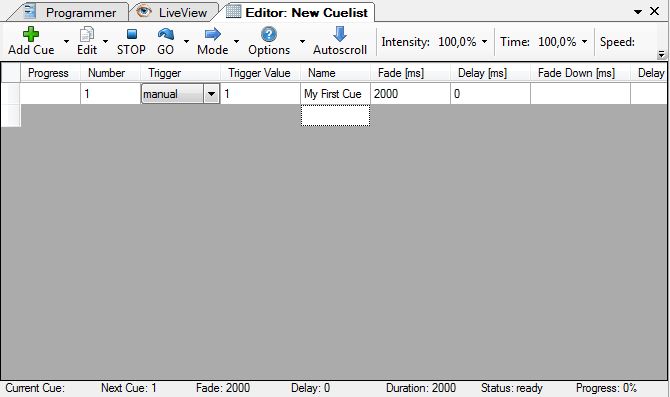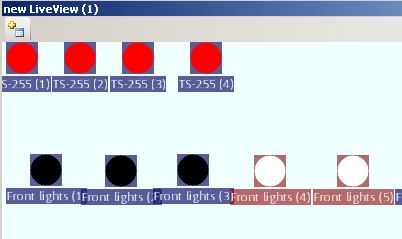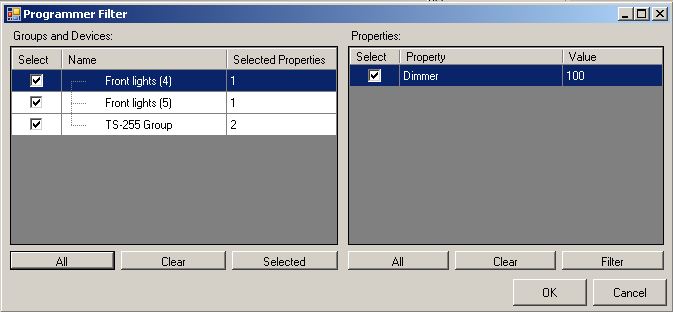No edit summary |
No edit summary |
||
| Line 3: | Line 3: | ||
| ueberschrift = First Steps: {{PAGENAME}} | | ueberschrift = First Steps: {{PAGENAME}} | ||
}} | }} | ||
{{NavigationTop-Tut3 | |||
| zurückLink = Lektion_7_Tut3 | |||
| zurückText = Lektion 7 | |||
| hoch = [[Tutorials DMXControl 3|Inhaltsverzeichnis]] | |||
| vorLink = Lektion_9_Tut3 | |||
| vorText = Lektion 9 | |||
}} | |||
{{DMXC3_lesson/en}} | {{DMXC3_lesson/en}} | ||
| Line 13: | Line 19: | ||
==Lecture 8: Scenes (cues) and scene lists == | ==Lecture 8: Scenes (cues) and scene lists == | ||
Each scene needs a "host container"- that's a scene list. | |||
Now the real work begins - we will create our first cue in DMXControl 3! All RGB lights will shine green. | |||
* We go to the'' 'Stage View''' | |||
* We select the 'Generic RGB PAR Group "(or choose from all RGB light with one of the other methods) | |||
* The intensity of the dimmer panel is pulled or the "Lumos" button pressed | |||
* In the Color panel "green" is selected . The 8 headlights in the '''Stage View''' should now respond accordingly (see figure) | |||
{{Bild_mit_Unterschrift |DMXC3L08 firstCue01.JPG|1|Einstellung der Scheinwerfer auf die gewünschte Einstellungen|center|700px}} | |||
* Click on the left, "Add new cue" | |||
* It opens a new window "Programmer filter", which we explain in Chapter 10, now first press OK. | |||
* Because we do not have any cue list one will be created now automatically. This is displayed in a new panel. | |||
* Here we rename the cue in the Name field to "My First Cue". | |||
{{Bild_mit_Unterschrift |DMXC3L08 firstCue02.JPG|2|Ansicht des Programmer Fensters|center}} | |||
Each scene needs a "host container"- that's a scene list. New cuelist can be created clicking the small triangle besides the "Add new cue" button and there follow the drop. Then again press "Add new cue!" | |||
| Line 20: | Line 46: | ||
[[File:DMXC3L08 firstCue02.JPG]] | [[File:DMXC3L08 firstCue02.JPG]] | ||
[[File:DMXC3L08 firstCue01.JPG]] | [[File:DMXC3L08 firstCue01.JPG]] | ||
[[File:DMXC3L08_createSceneListnew.JPG|600px]] | [[File:DMXC3L08_createSceneListnew.JPG|600px]] | ||
You can open this new cue list with a '''double click''' on the object in | You can open this new cue list with a '''double click''' on the object in the project explorer or using the context menu item "open" (or double click). | ||
In the tabular list then the individual parameters of the cue can be adjusted. | |||
[[File:DMXC3L08 changeLiveView.JPG]] | [[File:DMXC3L08 changeLiveView.JPG]] | ||
{{BoxHinweis | |||
|Text =The name of the cue should always be changed so that you can remember later quickly, what the cue includes (eg, "First scene", "Start cue", "ML Red", etc.). Not least, there is even a comment box at the far right in the scene list. | |||
}} | |||
The life cycle of a Cue is as following: | |||
{{Bild_mit_Unterschrift |DMXC3L08 SlideDMXC3cue.jpg|3|Lifecycle eines Cues in DMXControl 3|center|700px}} | |||
| Line 137: | Line 167: | ||
__NOTOC__ | __NOTOC__ | ||
__NOTITLE__ | __NOTITLE__ | ||
{{NavigationTop-Tut3 | |||
| zurückLink = Lektion_7_Tut3 | |||
| zurückText = Lektion 7 | |||
| hoch = [[Tutorials DMXControl 3|Inhaltsverzeichnis]] | |||
| vorLink = Lektion_9_Tut3 | |||
| vorText = Lektion 9 | |||
}} | |||
[[Kategorie:DMXControl 3]] | |||
Revision as of 15:05, 2 January 2013
{{#tree:id=dmxc3|openlevels=1|root=DMXC 3 lessons|
- preamble
- lesson 1: Installation and configuration
- lesson 2: The GUI panel concept
- lesson 3: Creating and patching fixtures
- lesson 4: The live view panel
- lesson 5: Setting properties with property panels
- lesson 6: Output plugins
- lesson 7: Summery and details - Setting
- lesson 8: Scenes (cues) and scene lists
- lesson 9: Fanning, chasers and other effects
- lesson 10: The programmer view
- lesson 11: Trigger concepts
- lesson 12: Editing scenes and scenelists
- lesson 13: Presets
- lesson 14: Summary and details - Programming
- lesson 15: Working with parallel scene lists
- lesson 16: Softpult
- lesson 17: Artnet
- lesson 18: Multi-media: Beamer tool, Matrix etc.
- lesson 19: Other clients and plugins (Android, iOS, ...
- lesson 20: Create new device definitions
- lesson 21: free topic
- lesson 22: Hints for testers and test reporting
- appendix1: Summary of commands ans shortcuts
- appendix2: Kernel menu tree
}}
Overview
Scenes (cues) are the most important elements of your show. Here we will explain the powerful scene concept of DMXControl 3. The terms "cue" and "scene" are used as synonym words.
Lecture 8: Scenes (cues) and scene lists
Now the real work begins - we will create our first cue in DMXControl 3! All RGB lights will shine green.
- We go to the 'Stage View'
- We select the 'Generic RGB PAR Group "(or choose from all RGB light with one of the other methods)
- The intensity of the dimmer panel is pulled or the "Lumos" button pressed
- In the Color panel "green" is selected . The 8 headlights in the Stage View should now respond accordingly (see figure)
Template:Bild mit Unterschrift
- Click on the left, "Add new cue"
- It opens a new window "Programmer filter", which we explain in Chapter 10, now first press OK.
- Because we do not have any cue list one will be created now automatically. This is displayed in a new panel.
- Here we rename the cue in the Name field to "My First Cue".
Template:Bild mit Unterschrift
Each scene needs a "host container"- that's a scene list. New cuelist can be created clicking the small triangle besides the "Add new cue" button and there follow the drop. Then again press "Add new cue!"
You can open this new cue list with a double click on the object in the project explorer or using the context menu item "open" (or double click). In the tabular list then the individual parameters of the cue can be adjusted.
| |
The name of the cue should always be changed so that you can remember later quickly, what the cue includes (eg, "First scene", "Start cue", "ML Red", etc.). Not least, there is even a comment box at the far right in the scene list. |
The life cycle of a Cue is as following: Template:Bild mit Unterschrift
Return to the scene list panel and press the Add new cue button. At first the programmer filter tool will appear where you can manually influence which devices and which attributes should be really taken over into the new scene. Typically you can confirm without modification.
The result is your first cue (scene) in your scene list. You should change the name of the cue thus you can remember laterly what is the reason and target of this cue (e.g. "First Scene", "Start cue", "ML to red", etc.)
You have to clean the programmer! Otherwise nothing will happen, when you press the play button. More details will follow in the next chapter.

In following table we explain the meaning of cue attributes (which you can see in the scene list header:
| Attribute | Description | Example |
|---|---|---|
| Progress | shows status of scene during execution of scene list | in percent |
| Trigger | relation to predecessor cue, use "follow" as default | see Lesson 11 |
| Trigger Value | see Lesson 11 | |
| Name | free name of scene | should explain the content of cue |
| Fade | fade-in value | in milli seconds |
| Delay | fanning for fades | see Lesson 9 |
| Act. | is this cue active or should it be ignored? | default: active |
| Ap. | Autoprepare (not yet implemented) | default: active |
| Comment | for free use, insert explaining words |
In the same way you can create some more cues and store it in the scene list.
Playing Back Cues
Go, Back, etc.
However you can also play a cue that is not in sequence by holding down CTRL and double clicking the cue you want to play.
Using Advanced Timing (=> Property Based Timing)
It is possible to set delay and fade times for each property. You can use this feature to build a cue that moves your moving lights to a different position, then changes the color and after that changes the gobo.
In property grid change "Values" to "Fade" or "Delay". You can now set fade or delay for each property. DMXControl expects time in milliseconds. Also you can use fanned values here. See Lesson 9.
The following example will immediately open the shutter and fade the intensity from 0 to 100% within 1 second (dimmer fade) after this 1 second (color delay) the color will be faded within 5 seconds (color fade). The total duration of this cue will be 6 seconds, because the longest action is the color fade: delay 1s + fade 5s.
Editing Property Based Timing
Once you saved a cue with property based timing you can edit the values: ... i guess should work but i don't know how.
topics to be added (by beta testers)
Excercise
- Generate your own cues
- Try the buttons "All", "Clear" and "Selected" in the programmer filter
- Work with different fade times
Additional links and references
Certificate
I have understood the topics of this lecture and want to continue with next course: Lesson 9
| |||||||||











